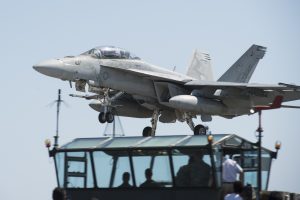Navy Lays Bare F/A-18 Readiness Gaps, Could Take Year to Surge Air Wing
By: Sam LaGrone
An F/A-18F Super Hornet, attached to the Diamondbacks of Strike Fighter Squadron (VFA) 102, assigned to Carrier Air Wing (CVW) 5, practices a touch-and-go landing on May 11, 2016. US Navy Photo
Three out of four F/A-18s are not ready to go to war and it could take up to a year for the Navy to pull together enough reserve fighters to field a surge force air wing, service officials told members of the House Armed Services Committee on Thursday.
A combination of warfighting demand, delays of the Lockheed Martin F-35C Joint Strike Fighter entering the fleet and sequestration cuts from the Budget Control Act of 2011 have left the Navy’s tactical aviation force just able to meet the basic requirements to combatant commanders, the commodore of Strike Fighter Wing Atlantic, Capt. Randy Stearns, told a joint hearing of the HASC readiness and seapower subcommittees.
Stearns said a few years ago, the Navy could have a reserve air wing ready to surge with a carrier strike group in 90 days.
Now, “it would take me six to 12 months,” to get another air wing ready to go to deploy with a carrier strike group due to lack of reserve forces,” he said.
“There’s nothing to pull from in the back,” Stearns told seapower chair Rep. Randy Forbes (R-Va.) in response to a question.
“We’ve already pulled everything forward. There’s nothing left.”
The Hornet and Super Hornet community are overextended for three prime reasons, officials outlined:
- Demand for strike fighters to support missions in U.S. Central Command that has driven hours up for the deployed fleets.
” We’re chewing up about 40 aircraft worth of hours a month and if we’re not buying that much or putting that much through the depot – we’re falling behind,” Stearns said. - A delay in deploying expected F-35C squadrons that prompted the Navy to extend the life of five squadrons of legacy Hornets the service anticipated it would retire. The Hornet extension, creating a maintenance backlog at the service’s aviation depots. That in turn, will push back the availabilities of Super Hornets in line to start their 6,000 hours maintenance periods.
“The depots were never set up to do high flight hour, which means essentially we’re extending them past the [6,000 to 10,000] hour life they were ever expected to fly just to meet the operational demand,’ Stearn said.
“Now they’re forced to have a three-year lead time to get the parts they need to get them in there – and it’s all a capacity problem.” - Funding challenges from the 2011 BCA to fully fund and man the depots.
According to F/A-18 depot information provided to USNI News, the service has a backlog of 91 F/A-18s waiting to enter maintenance — up from just one in Fiscal Year 2012 and 23 aircraft in Fiscal Year 2014.
There is also a backlog of 539 engines and modules, up from 11 in FY 2012 and 237 in Fiscal Year 2014.
With the limitations, to support ongoing missions from the one in four aircraft deployed, the service has had to route supplies to deployed units from ones on shore and even pull parts off idle aircraft to get to squadrons out at sea.
“Cannibalization, or taking parts off an airplane, that is our last resort. We work through the supply system and as you know our A through Ds are stuck in the depot because of unforeseen utilization. Our Super Hornets – we’ve had parts problems over the last few years starting in 2012 due to sequestration and some other factors, but we’ve never caught up really,” Stearns said.
“That’s a regular occurrence.”
For example, to support the recently announced extension of the Truman Carrier Strike Group (CSG) to continue strikes against ISIS in Syria and Iraq as part of Operation Inherent Resolve (OIR), Stearns had to identify three squadrons to use as a source for spare parts to keep the four Super Hornet squadrons in Carrier Air Wing 7 flying.
“I have three squadrons I had to call and tell ‘be ready, you’re the donors for the Truman extension’,” he said.
“That was not paid for. That was unforeseen and that’s a tax back here on the system.”
Back to Top



